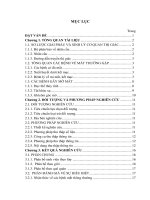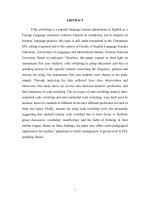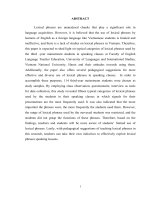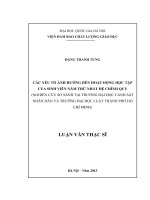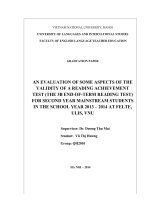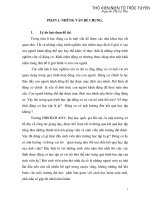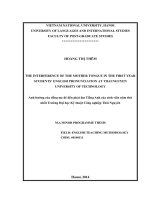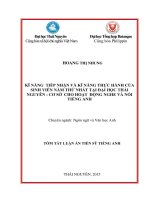NHẬN ĐỊNH của SINH VIÊN năm THỨ NHẤT hệ đại TRÀ KHOA sư PHẠM TIẾNG ANH về tài LIỆU NGHE THỰC BẰNG TIẾNG ANH
Bạn đang xem bản rút gọn của tài liệu. Xem và tải ngay bản đầy đủ của tài liệu tại đây (456.39 KB, 79 trang )
ABSTRACT
Under communicative approach, authenticity has gradually been integrated in
foreign language classrooms, which has also happened to first-year students studying
in Faculty of Language Teacher Education (FELTE) in University of Languages and
International Studies (ULIS). An obscure example for this is their English course
outlines with more involvement of authentic tasks and materials. However, while
previous researchers emphasize the role of leaner authenticity, this matter is rather
overshadowed in recent studies in ULIS. To fill in this gap, a research on FELTE
first-year students' perceptions of English authentic listening materials (EALM) was
conducted. This paper investigated the perceptions of 26 first-year FELTE
mainstream students selected by convenience sampling method. Three instruments
namely journals, questionnaires and semi-structured interviews were employed to
collect data which were analyzed by qualitative and quantitiative methods. The
results showed that nearly 90% of the participants like being exposed to EALM in
their classrooms and their most favourite types of EALM were songs, movies,
cartoons and quiz shows. Different opinions about EALM's advantages and
disadvantages were also gathered, in which students showed high levels of
agreement with all suggested benefits but seemed to be neutral about EALM's
disadvantages, except for EALM's inefficiency in language improvement which was
generally disagreed. This paper also drew out some factors to consider when
choosing EALM and included some unanticipated expectations of students towards
EALM exploitation in classrooms. Finally, implications about EALM's position and
suggested ways to select and apply EALM in classrooms were remarked for more
effective authenticity integration.
i
TABLE OF CONTENTS
ABSTRACT i
TABLE OF CONTENTS ii
LIST OF TABLES, FIGURES, AND ABBREVIATIONS v
PART 1: INTRODUCTION 1
1.1 Rationale and statement of the problem 1
1.2 Aim of the study 2
1.3 Research questions 2
1.3 Scope of the study 2
1.4 Significance of the study 3
1.5 Methods of the study 3
1.6 Thesis structure 3
PART 2: DEVELOPMENT 5
CHAPTER 1: LITERATURE REVIEW 5
1.1 Materials in English language teaching 5
1.2 Authenticity and Authentic materials 6
1.2.1 Authenticity 6
1.2.1.1 Definition 6
1.2.1.2 Types of authenticity 6
1.2.2 Authentic materials 7
1.2.2.1 Definition 7
1.2.2.2 Advantages of using authentic materials 8
1.2.2.3 Disadvantages of using authentic materials 11
1.2.2.4 Types of authentic materials 12
ii
1.3 Related studies on students’ perceptions of authentic materials 13
1.3.1 In the world 13
1.3.2 In Vietnam 14
CHAPTER 2: METHODOLOGY 17
2.1 Settings, participants and sampling method 17
2.1.1 Settings 17
2.1.2 Sampling method 18
2.1.3 Participants 18
2.2 Data collection method and procedure 20
2.2.1 Data collection instruments 20
2.2.1.1 Journals 20
2.2.1.2 Questionnaires 21
2.2.1.3 Interview 22
2.2.2 Data collection procedure 22
2.3 Data analysis method and procedure 24
2.3.1 Data analysis method 24
2.3.2 Data analysis procedure 24
CHAPTER 3: FINDINGS AND DISCUSSION 28
3.1 Findings 28
3.1.1 Research question 1: What are first-year students’ favourite types of
English authentic listening materials? 28
3.1.2 Research question 2: What are advantages of English authentic listening
materials as perceived by first-year students? 30
3.1.3 Research question 3: What are the disadvantages of English authentic
listening materials as perceived by first-year students? 32
iii
3.2 Discussion 36
3.2.1 Students’ favourite types of EALM 36
3.2.2 Advantages of EALM in students’ perceptions 37
3.2.3 Disadvantages of EALM in students’ perceptions 39
3.2.4 Some worth-considering factors drawn from students’ perceptions 40
3.2.5 Other students’ expectations of EALM exploitation in ELT 42
PART 3: CONCLUSION 44
1.1 Summary of the findings 44
1.2 Implications from the findings 44
1.3 Limitations of the study 45
1.4 Suggestions for further research 46
REFERENCES 47
APPENDICES 51
APPENDIX 1: LISTENING TASK CATEGORIZATION 51
APPENDIX 2: LISTENING EXERCISES DESIGNED FOR VIDEO 4 52
APPENDIX 3: GUIDING QUESTIONS FOR JOURNAL 54
APPENDIX 4: AN ENTRY FROM STUDENTS' JOURNALS 57
APPENDIX 5: QUESTIONNAIRES 59
APPENDIX 6: TENTATIVE INTERVIEW QUESTIONS 65
APPENDIX 7: AN EXTRACT FROM STUDENTS' INTERVIEW 67
iv
LIST OF TABLES, FIGURES, AND ABBREVIATIONS
List of tables
Table 1: A comparison between authentic and non-authentic language 9
Table 2: Types of authentic materials 13
Table 3: Specifications of authentic materials chosen and their follow-up exercises 19
Table 4 Coding system for contents analysis 25
Table 5: First-year students' perceptions of EALM's advantages 30
Table 6: Students' perceptions of EALM's disadvantages 33
List of figures
Figure 1: Students' interest in in-class usage of English authentic listening materials
28
Figure 2: Students' favourite types of English listening authentic materials 29
List of abbreviations
CFL College of Foreign Language
EALM English authentic listening materials
EFL English as a foreign language
ELT English language teaching
FELTE Faculty of English language teacher education
ULIS University of Languages and International Studies
VNU Vietnam National University, Hanoi
v
PART 1: INTRODUCTION
1.1 Rationale and statement of the problem
As stated by Guariento & Morley (2001), since the mid 1970s,
communicative approach has been put forward as a new orientation in language
teaching, which also creates an awareness of developing students’ language skills
for the real world. This has brought along a need for teachers to integrate
authenticity in their EFL/ESL classrooms. To achieve this requirement, using
authentic materials is considered as an appropriate choice because it helps students
"refer to the contextually appropriate ways native speakers actually put the target
language in use" (Feng & Byram, 2002, p.59).
Taking authenticity into consideration, teachers in FELTE, ULIS has put
into use a totally new design for the course outline of English language practice
subjects for first-year mainstream students since the first semester of 2012. This
new curriculum integrates four language skills into two subjects which are English
for Social purpose and English for Academic purpose. This change is expected to
provide more chances for students to not only improve their language proficiency
at school but also use the language properly in real-life situations. Accordingly,
more authentic materials and tasks have been added to the curriculum.
One remark about authenticity is that it "is a characteristic of the relationship
between the passage and the reader and has to do with appropriate response"
(Widdowson, 1978, p.80), indicating that authenticity depends mainly on the
perceiver's response to the passage. Specifically in EFL classrooms, this notion
refers to the remarkable influence of learners' engagement since they authenticate
the sources during their learning process. From this viewpoint, it can be inferred
that using authentic materials in first-year FELTE classrooms is greatly affected by
student's perceptions of the materials.
Nevertheless, recent studies in ULIS have not paid much attention to
students' perceptions of authentic materials. Especially, little research has been
1
done to address this matter for first-year mainstream students in FELTE – the first
generation using the new course outline. This is the gap that the researcher expects
to fill in by conducting a study on "First-year FELTE mainstream students’
perceptions of English authentic listening materials."
1.2 Aim of the study
This study aims at:
• Describing students’ perceptions of English authentic listening materials;
and
• Drawing out factors to consider when choosing English authentic listening
materials to be exploited in English language practice subjects;
1.3 Research questions
This study is hoped to find the answers to the following research questions:
Research question 1: What are first-year students’ favourite types of English
authentic listening materials?
Research question 2: What are advantages of English authentic listening
materials as perceived by first-year students?
Research question 3: What are disadvantages of English authentic listening
materials as perceived by first-year students?
1.3 Scope of the study
The samples of the study were 26 first-year mainstream students in FELTE –
ULIS using the new syllabus. Among various types of authentic materials, English
authentic listening materials were chosen to be investigated as they covered almost
all advantages and disadvantages related to linguistic features mentioned in
previous studies. If the students were exposed to as many of those features as
possible, their sharings would provide thorough and in-depth data for the study.
2
Besides, though students' perceptions were stated to be the focus of the
whole study, the limited capacity of the paper only concerned three aspects which
are students' opinions about their favourite types of EALM, EALM's advantages
and EALM's disadvantages.
1.4 Significance of the study
As this paper was expected to provide a valid description about students’
perceptions of authentic materials, its findings would be a reference for the teachers
to consider some appropriate ways of choosing and exploiting authentic sources.
Regarding students, especially the participants, this paper would provide them with
new sources of material outside course books which might be effective for their
own self-practice. Finally, researchers having the same concern in the topic might
take some useful information from this study for their own research in the future.
1.5 Methods of the study
In this research, qualitative method was mainly used to indicate students’
perceptions of EALM gathered from the journals and semi-structured interviews.
However, quantitative method was also employed to point out which types of
EALM were of students’ favourites and their general viewpoints towards some
particular EALM's advantages and disadvantages.
1.6 Thesis structure
The study is outlined with 3 parts as follows:
Part 1 – Introduction
This part states the research problems, the significance of the study and proposing
research questions.
Part 2 – Development
This part comprises of three chapters.
3
Chapter 1 – Literature review – includes the explanation of key definitions
as well as the review on different previous studies.
Chapter 2 – Methodology – comprises of research setting, participants and
sampling method; together with methods and procedure in data collection
and data analysis.
Chapter 3 – Findings & Discussion – presents research findings with further
thorough and thoughtful discussion.
Part 3 – Conclusion
This last part summarizes the findings, limitation of the research, pedagogical
implications and suggestion for further studies.
4
PART 2: DEVELOPMENT
CHAPTER 1: LITERATURE REVIEW
This chapter explains some key concepts as well as provides further
synthesis and analysis of relevant theoretical viewpoints. From that review, the gap
of the research is pointed out in relation to the context of the study.
1.1 Materials in English language teaching
In a study about ELT materials, Oura (2003, p.66) reports there is a rather
wide range of materials available to satisfy teachers’ needs. Those materials can be
commercially produced or "locally designed" for teaching various aspects of the
language. Moreover, Oura takes notice of teachers' adapting outside sources that
they find useful for promoting learning. Specifically, implementing authentic
materials is among teachers' selection to help incorporating "the real world context"
into the lessons to better their teaching students' language learning.
While Oura just raises an idea about varying the sources in ELT, Gordon
(2006) elaborates more on this need by giving critical comments on EFL textbooks.
Gordon asserts most EFL/ESL teachers have been dissatisfied with materials and/or
textbooks comprising of unnatural communicative situations of the language, partly
because "the vast majority of ESL material is written based on the material writers'
personal preferences, instituitions and predictions about linguistic performance
instead of actual behaviour" (p.1). Although there is a slight overgeneralization in
Gordon's perception, this viewpoint somehow reflects a demand that ESL textbooks
need supplementing by other sources which expose students to more natural and
authentic language.
The above opinions put forward a demand for diversifying ELT materials
beyond the boundaries of the given textbooks or course books, explicitly extending
to authentic sources outside the classroom. For that reason, this paper subscribes to
material diversity and focuses on using authentic materials in the following parts.
5
1.2 Authenticity and Authentic materials
1.2.1 Authenticity
1.2.1.1 Definition
Gilmore (2007) regards the definition of "authenticity" ambiguous since
there has been confusion between the characteristic of the material and the
perceiver's engagement with it. This author lists out eight "inter-related" possible
meanings and concludes that "the concept of authenticity can be situated in either
the text itself, in the participants, in the social or cultural and purpose of the
communicative act, or some combination of these" (p.98). Nevertheless, this
conclusion includes some overlap between the purpose of the communicative act
and the participants. While Gilmore distinguishes these two items as separate cases
of authenticity, the researcher perceives communicative acts' purpose basically
orginate from the participants themselves.
This ambiguity in Gilmore's conclusion is worked out by an older viewpoint
of Widdowson (1978): "Genuineness is a characteristic of a passage itself and is an
absolute quality. Authenticity is a characteristic of the relationship between the
passage and the reader and has to do with appropriate response" (p.80). It is visible
that Widdowson's ways of defining are more understandable as the characteristic of
the material and the perceiver's response to it are easily identified in two separate
terms – "genuiness" and "authenticity". The above notion is then voiced in
Mishan's 2005 study in which the author would rather produce a set of criteria to
recognize "authenticity" than define it. Similar to Widdowson's viewpoint, one of
Mishan's criteria regards authenticity as a factor of the "learners’ perceptions of and
attitudes to, the text and the activity pertaining to it" (p.18). This paper, therefore,
adapts the definition suggested by Widdowson in which "authenticity" is formed by
learners' engagement with the text.
1.2.1.2 Types of authenticity
6
Authenticity can be classified into four types according to McDonald et al.
(2006, pp.251-253).
• Text authenticity: This type "features the collocation of the word authentic
with the terms ‘language’, ‘text’, or ‘materials’". Within this point,
authenticity refers to "a correspondence between ‘pedagogic’ language,
texts, or materials, and ‘real world’ language, texts or artifacts."
• Competence authenticity: The learner’ competence of the language being
taught is among the expected outcomes of language teaching. It is
authenticated when learners can interact and create correspondence with an
idealized or a native speaker.
• Classroom authenticity: This type stresses on the role of teaching context in
providing the condition for the social practice of language teaching and
learning, in which the learners can "share the problems, achievements and
overall process of learning a language together as socially motivated and
socially situated activity" (Breen, 1985)
• Learner authenticity: The concept of learner authenticity as perceived by
Widdowson (1978) is the learner’s response to the text. This notion implied
that there should be "a shared convention" between learners and the native
speaker or writer so that learners respond appropriately to the materials. On
this argument, learners’ awareness of "target language" should be raised and
concerned about by the language teachers.
Like the definition, classification of authenticity also involves learners as a
vital factor affecting authenticity integration into EFL classrooms. Being aware of
this fact, the researcher regards learner authenticity as the thread of the whole paper
and narrows it down to students’ perceptions of authentic materials.
1.2.2 Authentic materials
1.2.2.1 Definition
7
Like "authenticity", the term "authentic material" is also perceived in
different ways by different researchers. To define whether a type of material is
authentic or not, Bacon & Finnemann consider whether "it is produced by and for
native speakers of the target language" (p.469). Nonetheless, this idea somehow
restricts the range of authentic materials as nowadays English is spoken by various
people from different nationalities besides English native speakers. Filling in this
gap, Lee (1995, cited in Al-Musallam, 2009, p.12) emphasizes the "primacy of
communicativeness" which relates "authentic material" to ones that are produced
not for the purpose of teaching but for real-life communication. Similarly, Nunan
(1988) provides a rather comprehensible definition and illustration of authentic
materials as follows:
Authentic materials are usually defined as those which have been produced for
purposes other than to teach language. They can be culled from many different
sources: video clips, recordings of authentic interactions, extracts from television,
radio and newspapers, signs, maps and charts, photographs and pictures, timetables
and schedules. (p.99)
This paper adapts the definition proposed by Nunan (1988) and investigates
more on learners' perceptions of EALM under the perspectives of Widdowson
(1978) and Mishan (2005) about learner authenticity as discussed above.
1.2.2.2 Advantages of using authentic materials
First and foremost, various researchers agree on the point that authentic
materials provide exposure to real language which is not regularly seen in
textbooks (Martinez, 2002; Omari, 2009; Guariento & Morley, 2004; Su, 2008).
Martinez (2002, para.11) justifies that unlike authentic sources, textbooks often
exclude "incidental or improper English" which is frequent in real-life language.
Authentic materials such as books, articles, newspapers and so on are resourceful
of text types and language styles variation used in many aspects of life. More
specifically, "listeners are exposed to how people speak, how they display
hesitations, pauses, false starts, topic shifting, incomplete structures and the like"
(Omari, 2009, p.43). Those characteristics of authentic materials are claimed to
8
convey "genuine speech" to the listeners and "are totally the converse of non-
authentic ones." More understanding of this difference can be acquired from one
detailed comparison between authentic and non-authentic language in the table
below (see Table 1).
Table 1: A comparison between authentic and non-authentic language
AUTHENTIC LANGUAGE NON-AUTHENTIC LANGUAGE
• Variation in the speed of delivery often
fast
• Slow pace with little variation
• Natural intonation • Exaggerated intonation pattern
• Natural features of connected speeches:
elision
• Carefully articulated
pronunciation
• Variety of accents • Received Pronunciation
• Any grammatical structures natural to
the topic
• Regularly repeated structures
• Colloquial language • More formal language
• Incomplete utterances • Complete utterances
• Restructuring in longer more complex
sentences
• Grammatically correct sentences
• Speakers interrupt or speak at the same
time
• Speakers take careful turns
• Speakers use ellipsis (i.e. miss out parts
of sentences)
• Ellipsis infrequent
• Background noise present • Background noise absent
Source: Hedge, 2000, cited in Omari, 2009, p.37
Another advantage of authentic materials goes to their positive effects on
learners’ motivation. According to Martinez (2002), authentic materials arouse a
sense of achievement in learners’ minds as they think what they learn from the
materials is close to and even benefits their real lives. Learners can also read or
listen for pleasure if the topics are various and likely to be of their interests. This
idea is shared by Ross (2006) as the author believes authentic sources are likely to
be relevant to the students’ life and personal interests. It is this relevance that
makes students have more motivation in improving their language as they find
enhancement in proficiency level brings about meaningful values to their real lives.
In the same concern about relationship between authentic materials and learners’
motivation, Omari (2009) suggests these materials can draw students' greater
9
participation, help them building confidence, and "pave the way to learner’s
autonomy" (p.43).
Additionally, authentic materials are claimed to help learners enrich their
background knowledge. As stated by Martinez (2002), students are aware of the
current affairs as well as update their understanding about various fields through
listening to or reading authentic materials. Ngai’s 2003 study confirms this idea by
reporting in the findings that some of the respondents shared they could keep
informed of news worldwide and also gained a preliminary understanding about
particular topics via watching movies. Also, the materials' benefit in increasing
background knowledge is specified as increase in cultural understanding since
McGinnis and Ke (1992, p.238) concluded "through a carefully organized and
richly divergent variety of authentic materials, students can acquire […] the greater
ability to develop cultural understanding by themselves."
Last but not least, several studies have been conducted to prove that
authentic materials can be useful for improving language comprehension. To
illustrate this point, two following cases are typical examples of development in
reading and listening skill. A study investigating EFL College learners’ attitude
towards authentic reading materials carried out by Al-Musallam (2009) indicates
that the majority of participants strongly agreed authentic sources help them
improve their language proficiency better than textbooks did. Likewise, another
study by Sabet and Mahsefat (2012) was conducted to examine the impact of
authentic listening materials on EFL students at elementary level. The results
showed that the experimental group of students receiving authentic input performed
much better than the control group who used simplified one, from which the two
authors conclude that authentic materials can support students’ listening
comprehension progress.
In conclusion, as proved by some previous empirical studies, authentic
materials bring about significant benefits in terms of both linguistic and non-
10
linguistic aspects for language learners. Those advantages are truly worth
considering to be exploited in language teaching, especially in ELT.
1.2.2.3 Disadvantages of using authentic materials
On the upside, authentic materials offer linguistic and non-linguistic
advantages towards language teaching. On the downside, these sources contain
potential limitations that the teachers should think over to avoid countering
authentic sources’ positive effects. Those drawbacks are also mentioned by some
previous studies.
Some concerns fall on the difficulty level of authentic materials in
accordance with learners’ level. Factors causing the difficulty as discussed in
preceding papers primarily are background knowledge and linguistic characteristic
of the materials. As for the first factor, Tamo (2009, p.76) takes "headlines, adverts,
signs, and so on" as typical examples requiring a good cultural understanding and
consequently making the materials rather complicated to comprehend. Regarding
the second factor, authentic materials are said to contain so many structures and
vocabulary not direcly relevant to students' needs that lower levels may find the
texts difficult to understand (Martinez, 2002; Kilickaya, 2004; Omari, 2009). The
difficulty caused by linguistic features is also traced back to factors only appearing
in listening sources such as "speed of speech delivery, varying accents and
background noise" (Omari, 2009, p.44).
Interestingly, the aforementioned ideas about the level of difficulty are
linked to potential demotivation as well. Guariento and Morley (2001) believe
unlike at post-intermediate level, using authentic materials at lower levels may "not
only prevent the learners from responding in meaningful ways but can also lead
them to feel frustrated, confused and more importantly, demotivated" (p.348). In
the same regard, Kilickaya (2004, para.15) points out demotivation may happen
when the students "lack many lexical items and structures used in the target
language". This lacking, as believed by Omari (2009), possibly makes the materials
11
unnecessarily difficult and results in a complete loss in both students' motivation
and interest.
Besides, some cultural problems may be encountered when students are
exposed to foreign language authentic materials. Martinez (2002, para.20) states
that the texts can be "too culturally biased" and belong to a community that is
totally strange toward students' daily lives. In this sense, authentic materials
become inauthentic ones in learners’ perception. More seriously, Omari (2009,
p.45) explains that such culturally biased situations may arouse the "feeling of
hatred or repulsion towards the target language", as certain aspects reflected in the
materials may be considered taboos in learners’ own culture.
Finally, authentic materials are sometimes thought to be inefficient for
language teaching as some scholars do not see the value of using authentic
materials in particular contexts. To illustrate, a study by Kienbaum et al. (1986,
cited in Al-Musallam, 2009, p.27) reveals no significant difference in language
development of students using authentic materials and those studying in traditional
classrooms with text books. The same case is witnessed in Ngai's 2003 research
when some of the respondents thought that authentic materials provided no help for
language proficiency because learners just cared about the contents of the materials
but ignored practicing their skills. Some other participants said using authentic
materials was a waste of time which was supposed to be spent on exam practice.
What can be inferred here is that the efficiency or usefulness of such materials
should be stuck to exam relevance.
To sum up, authentic materials have some potential drawbacks including
level of difficulty, demotivation, cultural problems and inefficiency in language
improvement. These matters truly need addressing properly in order to limit their
counter-effects on teaching and learning.
1.2.2.4 Types of authentic materials
12
Some types of authentic materials are listed and classified by Gebhard
(1996, cited in Oura, 2003, pp.67-68) as follows:
Table 2: Types of authentic materials
Authentic Listening/
Viewing Materials
TV commercials, quiz shows, cartoons, news clips,
comedy shows, movies, soap operas, professionally audio-
taped short stories and novels, radio ads, songs,
documentaries, and sales pitches.
Authentic Visual
Materials
slides, photographs, paintings, children’s artwork, stick-
figure drawings, wordless street signs, silhouettes, pictures
from magazines, ink blots, postcard pictures, wordless
picture books, stamps, and X- rays.
Authentic Printed
Materials
newspaper articles, movie advertisements, astrology
columns, sports reports, obituary columns, advice columns,
lyrics to songs, restaurant menus, street signs, cereal boxes,
candy wrappers, tourist information brochures, university
catalogs, telephone books, maps, TVguides, comic books,
greeting cards, grocery coupons, pins with messages, and
bus schedules.
Realia (Real world"
objects) Used in
EFL/ ESL
Classrooms
coins and currency, folded paper, wall clocks, phones,
Halloween masks, dolls, and puppets, to name a few.
(Realia are often used to illustrate points very visually or
for role-play situations.)
Source: Gebhard, 1996, cited in Oura, 2003, pp.67-68
Referring to advantages and disadvantages of authentic material, the
researcher realized that while features of lexical items, or structures could be
acquired from all the four types, factors related to phonetics or phonology could
only be found in authentic listening materials. As this study longed to provide
thoughtful insight into students' perceptions, which should cover as many aspects
of the language as possible, the rest of the paper would focus on authentic
listening materials only.
1.3 Related studies on students’ perceptions of authentic materials
1.3.1 In the world
13
Chavez (1998) investigated learners’ perspectives on correlation between
materials' authenticity and their level of difficulty. The research was conducted on
randomly-chosen German language college students, and the result showed that
learners enjoyed working with authentic materials as they hardly related the "high
degree of authenticity" with "high degree of difficulty" (p.298). However, Chavez's
study just covers the difficulty level of the materials and leaves other concerns in
using authentic materials unaddressed.
Another research produced by Su (2008) discovers that ESL adult students
prefer authentic materials on the Internet to other sources. The author then implies
that the Internet plays an important role in boosting the intrinsic motivation of the
students in learning language. Nevertheless, this study only aims at finding
students’ preference towards sources of authentic materials and puts aside items
related to advantages and disadvantages.
Ngai (2003) explores students’ perception of authentic materials and its
relationship with language proficiency, in which EFL students with both high and
low levels of language proficiency were chosen to be investigated. The findings
indicated that students were aware of different authentic sources and had in-depth
sharing about the materials' advantages and disadvantages. Ngai’s study seems to
provide a thorough portrayal of learners’ attitudes towards most of the
aforementioned problems related to using authentic materials. This paper, therefore,
echoes the idea and framework proposed by Ngai (2003) to fill in the gap of the
research in the context of ULIS.
1.3.2 In Vietnam
In 2008, the Ministry of Education and Training in Vietnam approved of the
project "Teaching and learning foreign languages in the national education system
period 2008 – 2020." One of the project’s objectives concerns with training and
teaching students at colleges and universities to "use foreign language confidently in
communication" (Tran, 2011, p.1), which entails the need of letting students be
exposed more to real-life language. Consequently, rising investigations have been
14
put on using authentic materials to bridge the gap between the classrooms and
practical usage.
Vu (2006) examines "Using authentic materials on websites as
supplementary materials for teaching listening to 2
nd
year students at VNU-CFL".
This study provides a description about the use of the materials including types,
sources, ways and reasons for using them mainly from teachers' perspectives. Vu
also gets approached to exploring students' general opinions about EALM's
effectiveness or preference about the way EALM should be exploited. From that
investigation, the author portrayed advantages and disadvantages of EALM to draw
out suggestions about some exploitable sources and solutions to apply EALM
effectively. Differently, Pham (2008) studies designing listening task based on
authentic materials. This author discusses the situation of using EALM,
effectiveness of listening tasks based on authentic materials, obstacles and some
suggestions for more effective designing and implementation. As the research
problems may suggest, data for Pham's research was mainly taken from the
teachers, though students' ideas were included in evaluating the tasks' effect on
their performance.
It is undeniable that such studies so far have contributed to the research
field and to the practical situation as well. However, those studies have just covered
matters relating to using authentic materials mainly under teachers' perceptions.
Although students are involved in those studies, their reported responses to
authentic materials are still comparatively general and need more thoughtful
investigation.
Chapter summary
Authentic materials, as discussed above, hold a great significance but
contain particular problems that may counter their effects. Those problems partly
have their roots in EFL learners, necessitating more considerate investigation into
learners' perception. Conversely, previous studies in ULIS have not tackled this
problem deeply to keep up with rising authenticity integration into the new syllabus
15
for first-year students developed by FELTE. To contribute to this study area, the
researcher addresses students’ perceptions of English authentic listening materials
to dedicate for the new curriculum for first-year students in FELTE, ULIS and for
ELT in general.
16
CHAPTER 2: METHODOLOGY
In this chapter, detailed discussion about the setting, selection of
participants, methods and procedures used in data collection and data analysis
would be provided with thoughtful justification.
2.1 Settings, participants and sampling method
2.1.1 Settings
The study was conducted in Faculty of English Teacher Education (FELTE)
in ULIS. This university has long established its reputation as a prestigious center
for foreign language teaching. As stated on ULIS's website, FELTE was among the
leading units of the university in ELT research and development. Therefore, course
materials and curriculum in the faculty have been studied and adjusted regularly to
be closer to global trends of ELT.
The new syllabus for first-year students in FELTE was first applied in
school year 2012-2013. It highlights the communicative approach, in which English
language teaching involves two subjects namely English for Social purposes and
English for Academic purposes. Each subject consists of two smaller sub-subjects
entitled Speaking-Listening and Reading-Writing. Under that change, course
materials as well as classroom activities involve authenticity both in terms of text
and task. This syllabus is believed to be carefully constructed with thorough
reference to many ESL/EFL textbooks and ELT studies in order to build up a
consistent and effective curriculum.
First-year mainstream students in FELTE were the first generation applying
the new syllabus developed by the faculty for school year 2012-2013. At high
schools, they studied four language skills separately so they may possibly be under
high pressure to meet the requirements set in their new scheme. However, this also
means these students are given chance to study the language through many
authentic materials or authentic tasks. Besides, the teachers are also encouraged to
17
introduce authentic sources as supplementary materials which they find useful and
appropriate for their students. All those facts show that teaching and learning
English in FELTE - ULIS are heading towards authenticity in EFL classrooms.
2.1.2 Sampling method
Mackey & Gass (2005) comments "convenience sampling is the selection of
individuals who happen to be available for study" (p.122). This method was
employed to select the participants for the research. Putting in plain words, the
researcher had had chance to work with almost all members of one first-year
mainstream class in FELTE prior to the study. Class members, generally, had good
cooperative spirit and could collaborate well with the researcher with high
commitment. Due to this fact, 26 members of this class were chosen as participants
purposively with the hope that data would be of great reliability.
2.1.3 Participants
Participants were 26 first-year FELTE mainstream students ("students" for
short) majoring in English Teacher Education. Their age ranged from 18 to 19 and
they all came from the same class including one male and 25 female students. As
stated in their syllabus, these students were assumed to achieve the current English
proficiency level B1 according to Common European Framework of Reference for
Languages (CEFR).
As mentioned above, the participants were directly following the new course
outline of the faculty, thus they had chance to be involved in communicative tasks
and get approached to authentic materials introduced in course materials by their
teachers. Besides, some of the participants may have favorable conditions to access
English broadcast news, movies, soap operas, et cetera thanks to cable TVs or the
Internet. Some other students may spend money buying CD-ROM to enjoy music
videos, movies or films for entertainment. Thanks to current technology, they can
watch movies/films in original English audio with English or Vietnamese subtitles.
This variety in participants’ exposure possibly entails diverse and in-depth data in
their perceptions of English authentic materials.
18
During the study, the participants were asked to listen to four authentic
videos including a cartoon, an interview, a news report, and a documentary chosen
by the researcher. Specifically, each week the students were given one video with
the length from two to five minutes to listen at home. To ensure that those authentic
materials were compatible with the syllabus, their topics followed the weekly
predetermined themes in the course outline. Besides, listening exercises were
designed for each video to check students’ understanding and exposure to the
materials. These exercises were given to students as home listening right after they
had finished the lesson of the equivalent topics in-class and checked by the
researcher one week later.
To design the exercises, the researcher consulted the list of listening tasks
suggested by Ur (1996) (see Appendix 1) and asked for comments from the two in-
charge Listening-Speaking teachers of the participants. From that reference, the
researcher chose Answering questions, Multiple-choice question, and Cloze as the
formats of the exercises for four authentic videos (see Appendix 2).
All information about authentic materials as well as the follow-up tasks is
summarized in the following table:
Table 3: Specifications of authentic materials chosen and their follow-up exercises
Video Topic Description Exercises
1 Contacts A cartoon video produced by Compassion
Australia - a Christian charity organization – to
encourage sponsors to write letters to their
sponsored children.
• Answering
questions
• Cloze
2 Agriculture A short interview with an expert about
agroecology recorded by Transnational
Institute (TNI) - an international network of
activist-scholars who study global problems.
• Multiple-
choice
questions
• Cloze
3 Solutions A news report about straddling bus in China on
New Tang Dynasty (NTD) Television – a
Chinese television broadcaster.
• Cloze
4 Trade A documentary about fair trade for purple rice
in Laos on Deutsche Welle (DW) – a
Germany's international broadcaster.
• Multiple-
choice
questions
19
It should also be noted that for each video there was a short introduction and
definitions for some vocabulary. This provision was necessary for the participants
whose English proficiency were assumed to be at pre-intermediate level (or level
B1 according to CEFR), since To & Nguyen (2011) claim that pre-teaching about
the background and vocabulary of the materials used are important at lower or
more intermediate levels.
2.2 Data collection method and procedure
2.2.1 Data collection instruments
2.2.1.1 Journals
Journals are claimed to not only enhance insights into a matter which is
inaccessible from the researcher’s perspective alone, but also allow the flexibility in
collecting data as entries for the diaries can be completed according to participants’
schedule (Mackey & Gass, 2005). For this reason, the researcher chose journals to
gather detailed sharing reflecting students’ perceptions. Moreover, the participants
were not under time constraints to complete their writing, so they would have
several days to write and edit their entries before giving them to the researcher.
In this study, six students willing to share their opinions about authentic
materials were selected to write the journals. They used their mother tongue –
Vietnamese – to express their own opinions clearly as much as they wanted. There
was a set of guiding questions adapted from Ngai (2003) for the students to follow
(see Appendix 3). Briefly speaking, five questions were built up to investigate
different aspects in students’ perceptions of one particular type of EALM. To be
more specific, two questions asked about writer's general understanding of and
attitude towards the material; and the other three questions concerned writer's
perceptions about the material's difficulty level, advantages, and disadvantages.
Particularly for the question about difficulty degree, a range of EALM’s
components were provided so that the participants could provide detailed
explanation. These components were adapted from the comparison made by Hedge
(2000) between authentic and non-authentic language (see page 8). This instrument
20
